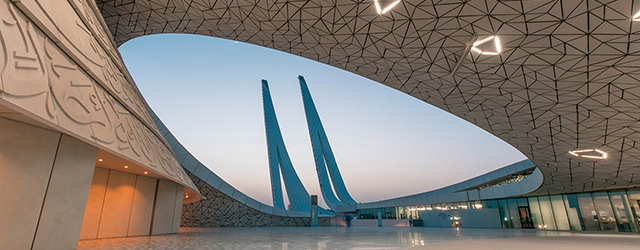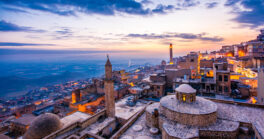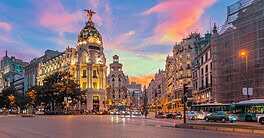The tiny emirate can rely on natural gas, infrastructure projects, foreign investment—and the World Cup—to weather a blockade by its neighbors.

A Second Regional HQ |
|
Since the Saudi Arabia–led blockade of Qatar began two years ago, doing business in the Gulf Cooperation Council states has become increasingly complicated. Flying from Dubai to Doha used to take an hour; now it can take five or six. Far from undermining investor confidence, the new reality has prompted businesses to reshuffle their geographical positioning. Foreign companies reluctant to pick sides or lose business now operate with dual headquarters: one in Dubai, one in Doha. “You virtually have two regions, so you can’t live off only one hub anymore. You need to go local,” says Ahmad Hafez, Qatar business director at Refinitiv. The Qatar Financial Centre, which allows 100% foreign ownership of enterprises, reports that the number of companies registered on its platform increased 31% in 2018. New members include companies based in the US, Canada, France, the UK, India and Pakistan, among other countries. |
Qatar, one of the world’s richest countries, is showing strong signs of economic recovery two years after Saudi Arabia, the United Arab Emirates, Bahrain and Egypt imposed diplomatic isolation.
“Qatar and its economy have turned the page,” says Bassel Gamal, CEO of Qatar Islamic Bank. After hitting a low of 1.6% in 2017, GDP growth is expected to reach 2.6% in 2019 and rise above 3% in 2020.
“Qatar has successfully adjusted to the dual shocks of lower oil prices and diplomatic rift,” the International Monetary Fund said in its latest Article IV consultation on Qatar, published in June. To circumvent the embargo imposed by neighboring countries, Qatar has developed new business partnerships and trades routes. Additionally, the government has called for a national effort to reach self-sustainability in all possible sectors of the economy.
“A New Spirit”
Qatar’s non-hydrocarbon sector recorded 5.3% growth in 2018, underpinned by massive infrastructure investments—including the new city of Lusail, the Doha Metro, the port of Hamad, the expansion of the international airport, and facilities for the 2022 World Cup (see sidebar on following page). Much of this infrastructure expansion has been financed with Qatari money thus far, but the authorities are also seeking greater foreign direct investment.
“There is a new spirit in Doha. After the blockade, Qatar needed to prove to the world that it could succeed. As a result, it developed local businesses you could never dream of, like a full-fledged dairy industry,” says Ahmad Hafez, Qatar business director at Refinitiv, an international financial market data provider.
Agriculture and food production were among the main concerns after Qatar’s only land border with Saudi Arabia was closed, drastically limiting imports. Today, Baladna, a Doha-based agricultural producer, claims to supply 95% of local demand for milk. It has also started exporting, and is expected to launch its initial public offering before the end of the year.
Hydrocarbons remain the backbone of the economy and the main driver for growth. In January, Qatar left OPEC, upping its wager that it can thrive on its own. The emirate holds the world’s third-largest liquid natural gas (LNG) reserves, which account for approximately 85% of its export earnings. Those gas fields aren’t expected to dry up anytime soon. Massive new projects are slated to go live in the next five years, including the Barzan facility (2020) and other offshore installations in the North Field. By 2025, Qatar projects it will have boosted its LNG output by 40%.
Close observers say the economy has room to grow in other directions, as well. Health care and education are among the most promising sectors. Qatar is expanding its hospital offerings and looking to attract specialized know-how from other countries. Similarly, the emirate is keen to welcome branches of Western universities and research centers to its Education City.
Over the past few months, Qatar has made considerable adjustments to its legal framework to meet the needs of international partners. After easing visa requirements and liberalizing tax laws, the government enacted a new investment law in January, removing the obligation for non-Qatari businesses to have a local majority shareholder. Essentially, all sectors of the Qatari economy are now open for FDI, except banking, insurance and defense.
Investing in Image |
|
The 2022 FIFA World Cup is far from the first international sporting event Qatar has hosted—but it’s by far the most ambitious. The emirate is investing hundreds of billions of dollars in sports facilities, while also revamping the country’s infrastructure. “Preparations are well underway for this exciting and much-anticipated event,” says Abdulla Al-Khalifa, acting group CEO of Qatar National Bank, which is involved in a number of auxiliary projects, including highway improvements, stadium construction and environmental activity. Will the event be profitable for Qatar? No, but that’s not the point. “It’s beyond economics; this is an investment in the security of the country,” says Danyel Reiche, professor of comparative politics at American University of Beirut. “This event puts Qatar on the global map at a time when its neighbors pose a threat. Without it, maybe Saudi Arabia would have already invaded.” |
Strong Financial Sector
Reflecting a thriving financial sector, Qatari banks recorded a 9.5% increase in net profit and 3.2% growth in total assets in 2018, according to KPMG. The Beirut-based Union of Arab Banks (UAB) credits high asset quality and high capitalization levels.
By the end of 2018, the nonperforming debt ratio at local banks remained below 2% while capital adequacy ratio stood at 17%, well above Basel III requirements. Liquidity levels remained comfortable, with the ratio of liquid to total assets reaching 29.1%, says the UAB.
Following the embargo, the main challenge for Qatar’s 18 lenders was to adjust to the withdrawal of Gulf Cooperation Council assets. “This was efficiently managed, with liquidity support provided by the government through foreign currency deposits,” notes Gamal. “Since then, there has been a withdrawal of public sector deposits as the liquidity situation normalizes.”
Banks have diversified their sources of non-domestic deposits, and following a regional trend are looking to consolidate assets. In April, Qatar completed its first bank merger when Bank Barwa took over International Bank of Qatar to form the country’s sixth-largest lender, with $22 billion in total assets. Other banks are currently looking at mergers and acquisitions as a way to grow locally and internationally.
“We will consider the potential of acquisitions on a purely opportunistic basis if suitable targets are available,” says Abdulla Al-Khalifa, acting group CEO of Qatar National Bank, the country’s largest lender. QNB aims to become a leader not only in the Middle East, but also in Africa and Southeast Asia.
A stable financial picture is one reason Qatari authorities say they are well prepared to cushion the shock if oil prices slide again. Doha plans to introduce a value-added tax in 2020, and is considering other changes in the coming months to encourage fiscal optimization, economic diversification and private-sector growth



